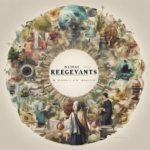In the late 18th and early 19th centuries, Georgian England embraced a style of portraiture that would come to define an era. Known for their distinctive elegance and simplicity, Georgian silhouettes offer a glimpse into the world of high society during a time of cultural enlightenment and societal upheaval. This article delves into the history of Georgian silhouettes, exploring their origins, popularity, and enduring legacy in the realm of portraiture.
Step Into the World of Cheryl Bolen
Dive into the enchanting stories of love, intrigue, and elegance set in the Regency Era. Cheryl Bolen's novels offer timeless romance and captivating tales that will leave you wanting more.
Explore Cheryl Bolen's Books Now
Origins and Evolution of Georgian Silhouettes
Origins of Georgian Silhouettes
Georgian silhouettes have a rich history dating back to the 18th century when they first gained popularity in Europe. The term “silhouette” itself comes from the French Minister of Finance, Étienne de Silhouette, known for his budget cuts and frugality. Silhouettes were originally a cost-effective alternative to traditional portraiture, as they could be quickly and inexpensively created by tracing a person’s shadow.
As the Georgian era progressed, silhouettes evolved into a popular form of portraiture among the upper class. These elegant black and white profiles captured the essence of the individual in a simple yet striking manner. Georgian silhouettes often featured intricate details such as hairstyles, clothing, and accessories, providing a glimpse into the fashion and trends of the time.
Evolution of Georgian Silhouettes
Over time, Georgian silhouettes became more elaborate and artistic, incorporating techniques such as cutting, painting, and shading to create detailed and lifelike portraits. Silhouette artists honed their craft, capturing not only physical features but also the personality and character of their subjects. The art of silhouette-making flourished during the Georgian era, with skilled artists gaining recognition for their unique and beautiful creations.
Today, Georgian silhouettes are valued not only for their historical significance but also for their artistic merit. Collectors and enthusiasts alike appreciate the timeless beauty and charm of these classic portraits, which continue to inspire and captivate viewers around the world.
Key Characteristics and Elements of Georgian Silhouettes
Key Characteristics:
Georgian silhouettes are known for their elegant and structured designs, typically featuring high waistlines and narrow skirts. These silhouettes were popular during the reign of King George I-IV in England, from 1714 to 1830. Georgian fashion was influenced by classical Greek and Roman styles, resulting in a look that was both sophisticated and refined.
Elements of Georgian Silhouettes:
- Empire waist: A defining feature of Georgian silhouettes, the empire waist sits just below the bust, creating a long and slender look.
- Puffed sleeves: Sleeves were often puffed at the shoulders, adding volume to the upper body and balancing out the narrow skirt.
- Elaborate embellishments: Georgian garments were often embellished with lace, embroidery, and intricate trimmings, showcasing the craftsmanship of the era.
Determining Authentic Georgian Silhouettes
When it comes to , one must delve into the rich history and cultural influences that shaped this unique style. Georgian fashion is known for its elegance, sophistication, and attention to detail, making it a popular choice for those looking to add a touch of classic charm to their wardrobe.
One key element to look for in authentic Georgian silhouettes is the emphasis on natural fabrics such as silk, cotton, and wool. These materials not only lend a luxurious feel to the garments but also allow for intricate detailing and delicate embellishments. Pay close attention to the quality of the fabric and the craftsmanship of the piece to ensure its authenticity.
Another defining feature of Georgian silhouettes is the use of structured silhouettes and tailored fits. Women’s dresses often featured fitted bodices and full skirts, creating a flattering hourglass shape. Men’s attire, on the other hand, typically included tailored coats, waistcoats, and breeches. The overall look was refined and polished, reflecting the elegance and grace of the Georgian era.
Preserving and Displaying Georgian Silhouettes
Georgian silhouettes are an important piece of history that deserves to be preserved and displayed for future generations to appreciate. These delicate works of art provide a unique glimpse into the fashion and society of the Georgian era, showcasing the silhouettes of individuals in profile.
When it comes to preserving Georgian silhouettes, proper care and handling are essential. These fragile pieces should be stored in acid-free materials to prevent deterioration over time. Displaying them in a controlled environment with low humidity and minimal exposure to light can help prolong their longevity.
For showcasing Georgian silhouettes, consider framing them in elegant, antique frames that complement the era in which they were created. Grouping silhouettes together in a gallery wall or creating a curated display can offer a visually stunning way to showcase these historical artworks in a modern setting.
Final Thoughts
Georgian silhouettes represent a unique and cherished art form that emerged during the reign of King George III in the late-18th century. These profiles captured the essence of their subjects with remarkable precision and simplicity, reflecting the elegance and refinement of the Georgian era. As we continue to study and appreciate this historical art form, let us not only admire the skill and craftsmanship of the artists who created these silhouettes, but also recognize the cultural significance they hold in preserving the image of an era that was defined by its sophistication and grace. Let us cherish and preserve these exquisite silhouettes as valuable artifacts that offer a window into the past and celebrate the legacy of Georgian portraiture.


